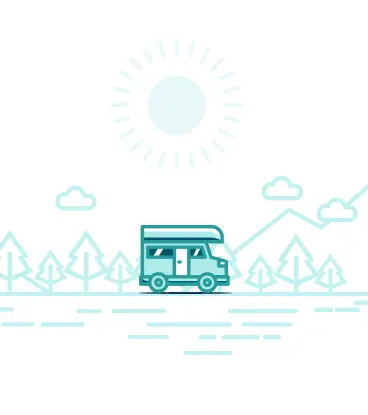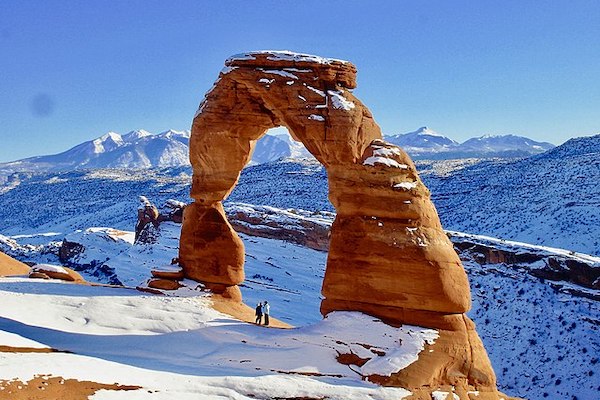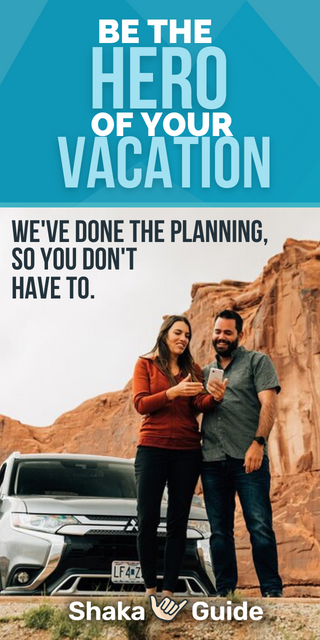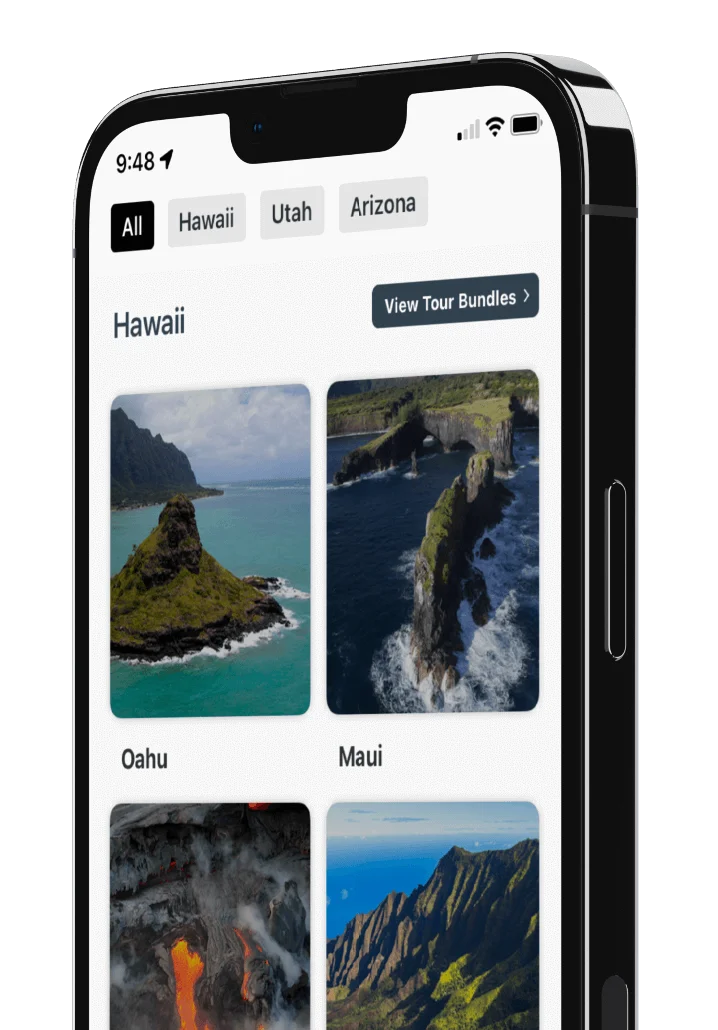
Best National Parks in Utah: Mighty 5 Travel Guide + Expert Tips
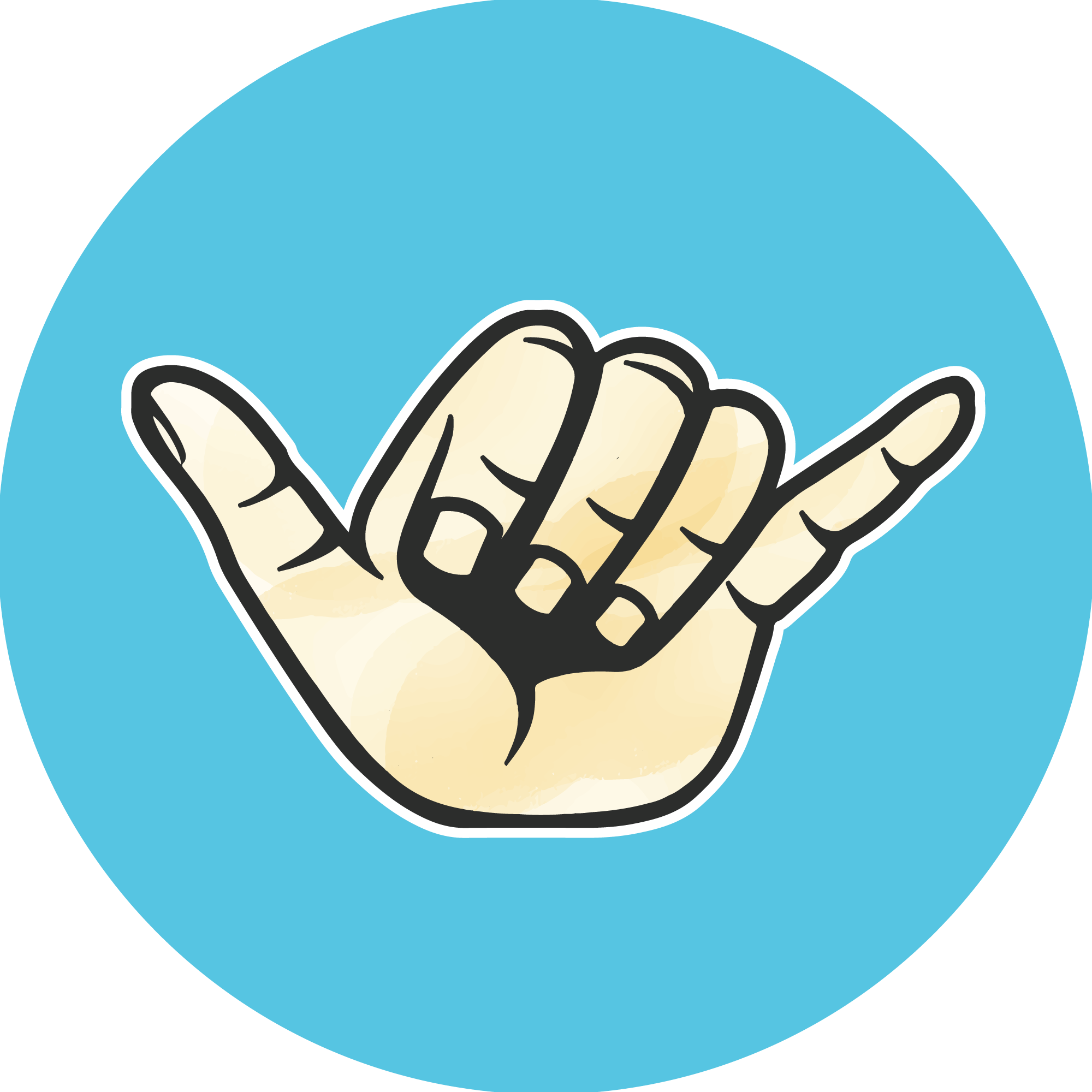
Southern Utah is home to a number of remote, rugged, and absolutely beautiful National Parks.
Known as “Utah’s Mighty Five,” these five National Parks often rank as some of the best in the nation.
But how do they rank among themselves? Let’s find out!
Zion National Park
Getting There
Getting to Zion National Park is a breeze! It’s located in southwestern Utah, about an hour outside the city of St. George.
That’s also the closest airport. If you’re driving to Zion, you can find it along Utah State Route 9, which connects to Interstate 89 to the east, and Interstate 15 to the west.
Best Time To Visit Zion
Zion National Park is open year-round, but some areas close in the winter due to heavy snow. Sometimes, that snow persists long into the spring. That’s why the best time to visit is Summer and Fall.
However, if you want to avoid the crowds and the heat of summer, Fall is your best bet. Zion is a hiker’s paradise, and hiking in the cool of the Fall is definitely the way to go.
Where to Stay/Eat
There’s no shortage of places to stay near Zion. There’s the Zion National Park Lodge, inside Zion Canyon.
You can find hotels, bed and breakfasts, and private rentals in the nearby towns of:
- Springdale
- Virgin
- LaVerkin
- Hurricane, and
- Mt. Carmel
Best Things To Do in Zion
 Shutterstock Image
Shutterstock Image
- Take Shaka Guide’s tour of Zion National Park!
- Hike The Narrows: This iconic slot canyon hike is a must-do for any experienced hiker visiting Zion. Wade through the Virgin River and marvel at the towering sandstone walls.
- Climb Angels Landing: A challenging hike with breathtaking rewards, Angels Landing offers panoramic views of the park.
- Explore the Emerald Pools: A series of beautiful waterfalls and pools nestled in a lush Zion canyon.
- Drive the Zion-Mount Carmel Highway: This scenic drive offers stunning views of the park's towering cliffs.
- Hike to The Watchman: A moderate hike that leads to the summit of this iconic sandstone peak.
- Stargaze in the Dark Sky Park: Zion National Park is a designated Dark Sky Park, offering some of the best stargazing in the country.
- Visit the Zion Human History Museum: Learn about the history and culture of the people who have called this region home.
- Kolob Canyons: This remote section of Zion National Park is characterized by its towering sandstone cliffs, deep canyons, and diverse ecosystems. It's a less-visited area of the park, offering a more peaceful and secluded experience.
- Riverside Walk: This flat and easy 2.2-mile trail follows the Virgin River as the sheer sandstone walls narrow in around you.
Cons About Zion
While Zion is indisputably stunning to look at, it does have its drawbacks. For one, the park can get extremely crowded.
Over 4.5 million people visit every year, and more than half of them visit between April and September.
That’s why, from March through November, you’re required to ride the park shuttle into Zion Canyon - no private vehicles allowed.
However, the other areas of the park, like East Zion and Kolob Canyons, allow private cars year-round.
Shaka Guide Tour
Shaka Guide’s tour of Zion includes all four areas of the National Park:
- Zion Canyon
- East Zion
- Kolob Canyons
- Kolob Terrace
We’ll share stories about Zion Canyon’s discovery, early history, conservation, and Native American legends.
Plus, we’ll cover top destinations, hiking trails, activities—and a whole lot more!
The tour has 4 starting points, so no matter where you’re coming from, Shaka Guide will meet you there.
Tips
Here are some Shaka Guide tips for visiting Zion:
- Get there early
- Visit in the Fall for the best combination of good weather and low crowds
- Angels Landing permits go fast, so get yours as soon as you book your trip.
- And don’t forget to download Shaka Guide’s tour of Zion National Park before you head out!
Bryce Canyon National Park
Getting There
Bryce Canyon is located along Utah’s Scenic Byway 12, about one hour’s drive east of Zion National Park, and 2 hours west of Capitol Reef National Park.
Bryce Canyon is also situated near the Grand Staircase-Escalante National Monument, and only 15 minutes away from the always photogenic Red Canyon area of the Dixie National Forest.
Best Time To Visit Bryce Canyon
The best time of year to visit Bryce Canyon National Park is…anytime! The park is open year-round.
That said, the visitor center has limited hours in the winter, and road and trail closures are possible due to snow.
The roads to Fairyland Point and Paria View are closed for the entire winter but are still accessible for hikers, cross-country skiers, and snowshoers.
However, looking out over the Bryce Amphitheatre when it’s covered in glistening white snow isn’t something you’ll ever forget!
Visiting Bryce Canyon in the summer will give you the best chance of seeing everything when it’s open.
But if you want to avoid crowds, consider booking your trip in Spring or Fall.
Where to Stay/Eat
If you want to stay close to the National Park, you can’t get much closer than inside the park, at the Lodge at Bryce Canyon.
If you prefer to be park-adjacent, look no further than the hotels of Bryce Canyon City, only a five-minute drive from the park’s entrance.
Best Things To Do in Bryce Canyon
 Shutterstock Image
Shutterstock Image
- Take Shaka Guide’s tour of Bryce Canyon National Park!
- Hike to Sunrise Point: This is the iconic viewpoint that offers breathtaking panoramic views of the hoodoos.
- Descend into the Amphitheater: Hike down into the heart of Bryce Canyon to get up close to the hoodoos.
- Explore Bristlecone Loop Trail: This trail meanders through the forest atop this highest portion of the park, passing by bristlecone pines up to 1,800 years old.
- Visit Navajo Loop Trail: This popular trail offers two options: a short loop with a stunning overlook or a longer loop that descends into the canyon.
- Stargaze in the Dark Sky Park: Bryce Canyon is a designated Dark Sky Park, offering incredible stargazing opportunities.
- Attend a Ranger-Led Program: Participate in a ranger-led hike, talk, or other program to learn more about the park.
- Visit the Fairyland Loop Trail: This short trail offers a glimpse of the park's unique hoodoo formations.
- Explore the Wall Street Canyon: This slot canyon offers a challenging but rewarding hike.
- Visit Mossy Cave: This is a hidden gem in Bryce Canyon National Park. A short but scenic trail leads to a small cave adorned with moss and ferns. It's a peaceful and tranquil spot, offering a refreshing break from the heat and crowds.
Cons About Bryce
Visiting Bryce Canyon isn’t without its risks. For one, there are geologic hazards like rockfalls and landslides, especially along the Under-the-Rim Trails.
Flash floods can also occur in the slot canyons, even when it's clear.
Then there’s the elevation, which can be a challenge for some people and can result in dehydration, elevation exhaustion, heart issues, and altitude sickness.
Shaka Guide Tour
When you take Shaka Guide’s tour of Bryce Canyon National Park, you can rest assured you won’t miss a thing.
We’ll take you through the entire scenic drive, and even to the lesser visited areas of Mossy Cave and Fairyland.
Along the way, you’ll learn more about the park than you thought possible.
Tips
Here are some Shaka Guide tips for visiting Bryce Canyon:
- If you get into the park before the sun is up, you can watch the sunrise over the Bryce Amphitheatre - a truly magical experience.
- If you only have a short time in the park, then you should prioritize the five Bryce Amphitheatre overlooks.
- If you’re visiting the park from April thru October, and you don’t want the hassle of looking for parking, then consider using the free shuttle service. Your Shaka Guide tour still works on the shuttle!
- Attend a Ranger program, or stay in the park after dark to be amazed by the night sky.
- Make sure you’ve got the Shaka Guide app installed on your phone, and the tour of Bryce Canyon National Park downloaded before you start your journey.
Arches National Park
Getting There
Reaching Arches National Park is a breeze! The park is only a five-minute drive from the heart of Moab, Utah, right along US Route 191.
You can fly into Moab’s small Canyonlands Regional Airport, or the larger Grand Junction airport, only 1.5 hours away, across the state border in Colorado.
From Grand Junction, just take Interstate 70 west, and then head south on 191 to reach Arches National Park.
Best Time To Visit Arches
Regardless of the season, Arches National Park offers stunning views of unique geological formations. The best time of year to visit truly depends on you!
In the summer, Arches is packed with visitors, and temperatures regularly reach up into the 90s.
July through September is Monsoon season, so there may be heavy rain and flooding.
Spring and Fall have milder temperatures and fewer crowds.
The closer you get to winter, the more you’ll have the park all to yourself.
But in winter, a lot of area businesses, like restaurants and hotels, close for the season.
Where to Stay/Eat
Looking for where to stay and eat while visiting Arches National Park? Look no further than Moab. Moab is ground zero for exploring the area, which includes:
- Arches National Park
- Canyonlands National Park
- La Sal Mountains
If you’d rather not stay downtown, in the thick of Moab, there are plenty of more remote lodges and accommodations in the wider area, like the Red Cliffs Lodge, and Sorrel River Ranch.
Best Things To Do in Arches
 Shutterstock Image
Shutterstock Image
- Take Shaka Guide’s tour of Arches National Park!
- Explore the Arches: It’s why the park exists, after all! No visit to Arches would be complete without visiting some of the most famous arches in the world, like the Delicate Arch, Double Arch, the Windows, and Landscape Arch.
- Go on Stunning Hikes: If you plan to visit Delicate Arch (and you really should), then you’ll need to hike there. And since you’ll be wearing your hiking shoes, here are a few other hiking trails we recommend: Devil’s Garden Primitive Loop, Fiery Furnace (reservations required), and the easy Double Arch trail.
- Observe Desert Wildlife: Despite the harsh desert wilderness of Utah, there is still a thriving ecosystem of plants and animals living in cracks and crevices in the rock. During your visit, you can keep your eyes out for rabbits, lizards, eagles, deer, and so much more!
- Check out Arches’ Ranger Programs and Visitor Center: The ranger programs in Arches National Park offer an educational experience for visitors. They provide insight into the park's geology, ecology, and cultural history.
Cons About Arches
The most challenging thing about visiting Arches National Park is just how busy it gets.
That’s why, from April through October, Arches requires timed entry reservations.
Reservations sell out quickly, so make sure you get yours as soon as you confirm your travel plans.
However, if you can’t get a reservation, there’s still hope! The National Park is open 24 hours a day.
So, if you enter the park before 7 am or after 4 pm, you won’t need a reservation. But you will still need your National Park pass.
Shaka Guide Tour
Even though Arches National Park only has one official entrance, we’ve designed our Shaka Guide tour so you can explore the park in two different ways.
You can take the more traditional tour, which recommends stops as you first approach them.
Or, if you’re an early bird who wants to hike to Delicate Arch before the crowds arrive, we’ll take you to Delicate Arch first, and then visit stops on the way back to the entrance.
Either way, you’re bound to have a blast.
Tips
Here are some Shaka Guide tips for visiting Bryce Canyon:
- Purchase your timed entry as soon as you can. Remember though, even without a reservation, you can still enter the park before 7 am, and after 4 pm.
- Be patient. Arches gets crowded, which means long lines, packed parking lots, and lots of people.
- Arches is in the desert, so bring plenty of water and salty snacks.
- No pets allowed, so leave Rover at home.
- Most importantly, remember to take Shaka Guide along with you, to make the most out of your visit!
Canyonlands National Park
Getting There
Getting to Canyonlands is almost as easy as getting to Arches. Both national parks are found near Moab, Utah, but Canyonlands requires a bit more driving to reach the front gate.
Shaka Guide’s Canyonlands National Park tour will take you to the Island in the Sky district - a marvel of geology and scenic views that stretch on for hundreds of miles.
To start the tour, head west on Utah State Route 313, just north of Moab, by the Moab Giants Dinosaur Park.
Best Time To Visit Canyonlands
When you get right down to it, there isn’t a bad time to visit Canyonlands National Park.
Whether hot or cold, crowded or empty, the natural beauty of the park’s Island in the Sky district is always there.
Canyonlands is open year-round, so the best time to visit depends on you. Don’t mind the heat or the crowds?
Then visit during the summer. Or, if highs of 30 degrees Fahrenheit are what you’re looking for, then book your trip for the winter.
Fall and Winter usually have the best compromise of decent weather and fewer crowds.
Where to Stay/Eat
If you’re visiting Canyonlands for more than a few hours, then you’re probably staying in nearby Moab, Utah.
Moab has all the restaurants, accommodations, and shopping you’ll need during your visit.
Best Things To Do in Canyonlands
 Shutterstock Image
Shutterstock Image
- Mesa Arch: You can enjoy the sunrise or sunset over the canyons from Mesa Arch, which is a short walk from the rest of the Island in the Sky District.
- Grand View Point Trail: A stunning panorama of the canyons, featuring the Colorado River snaking through the landscape, may be seen on this 1.8-mile roundtrip climb.
- Upheaval Dome Trail: This moderate 1.5-mile trail takes you to two separate overlooks peering into an intriguing geological formation, believed to be the result of an ancient meteorite impact or a salt dome uplift.
- Watch for Wildlife: Plants and animals prosper despite the dry climate. It's possible to spot the following wildlife: The world-famous Canyonlands bighorn sheep, the black-tailed jackrabbit, the western collared lizard, and more.
- And don’t forget the views! The Sky Island District is about 6,000 feet above sea level and offers incredible views of the canyons, rivers, and valleys below.
Cons About Canyonlands
Most of the risks of visiting Canyonlands are related to its location and climate. In the summer, there are serious risks of heat exhaustion and dehydration.
Rain and flooding can also be an issue during the Monsoon season, June through September.
Shaka Guide Tour
Shaka Guide’s tour of Canyonlands only includes the park’s Island in the Sky District.
The other two areas of the park, The Needles and The Maze are much too remote and rugged for most vehicles.
Even still, this tour takes at least 4 hours to complete, so it’s easy to spend your whole day in Canyonlands with Shaka Guide.
We even take you to the nearby Dead Horse Point State Park. Two parks for the price of one!
Tips
Here are some Shaka Guide tips for visiting Canyonlands:
- Make sure you’re headed to the correct district of Canyonlands: Shaka Guide’s tour only goes to the Island in the Sky.
- Be patient. Canyonlands National Park gets crowded, which means long lines, packed parking lots, and lots of people.
- Bring plenty of water and sun protection.
- If you’re hiking, wear proper shoes, and always stay on marked trails.
- Remember to download your Shaka Guide tour of Canyonlands at your hotel, before you set off on your adventure! Shaka Guide tours work offline, which is good because service can be spotty in the park.
Capitol Reef National Park
Getting There
Capitol Reef National Park is smack in between Arches and Canyonlands in the east, and Zion and Bryce Canyon in the west.
You can find Capitol Reef along Highway 24, between the towns of Torrey and Hanksville.
Best Time To Visit Capitol Reef
For most of the national parks on this list, the best time to visit is pretty much whenever it suits you best.
But for Capitol Reef, we think the best time to visit is July through September. Why? Well, that’s harvest season!
You see, Capitol Reef is home to the pioneer-era town of Fruita, and it still maintains orchards where you can pick and eat:
- apples
- peaches
- plums
- cherries
- nectarines
- pears, and more!
However, that also coincides with monsoon season, which means the park is susceptible to flash flooding.
If you’d rather avoid the rain and crowds, Capitol Reef, then consider visiting in Spring, when the fruit trees are in blossom.
Where to Stay/Eat
The nearest town to Capitol Reef, and the one with the most options for restaurants and accommodations, is Torrey. Torrey is just 15 minutes west of the National Park entrance.
If you’d prefer to stay further away from the crowds, then consider staying in Hanksville, about 40 minutes east of the park.
Best Things To Do in Capitol Reef

- Take Shaka Guide’s tour of Capitol Reef National Park! Although the tour only takes you between Torrey & Hanksville, and down along the main scenic drive, there’s actually a lot more to the park! The northern section is known as Cathedral Valley and features many iconic rock formations. The southern part of the Waterpocket district offers some incredible hiking and canyoneering. These additional areas usually require high-clearance, all-wheel drive vehicles.
- Fruit picking in the Fruita Orchards
- Hike to Cassidy Arch, a natural stone arch inside Grand Wash
- Historical Sites. Capitol Reef is filled with preserved historical sites, like the Behunin Cabin, Fruita Schoolhouse, Petroglyph Panel, Pioneer Register, and so many more
- Hickman Natural Bridge, is a short hike to a stunning natural stone bridge.
- Hike through the Capitol Gorge, with an optional turn-off for The Tanks. The Tanks is a series of depressions in the ground that store water, also known as waterpockets.
- Outside the park, but still part of the tour, is the stunning Skyline Rim Overlook. You can find it near Hanksville, along Factory Butte Road.
Cons About Capitol Reef
Perhaps the biggest danger to be aware of while visiting Capitol Reef is the potential for flash floods.
From June through September, heavy rains can mean devastating and sudden flooding of the canyons, washes, and gorges inside the park.
Never enter a canyon if it’s raining, and think twice if you even see rain clouds in the distance.
Flash floods travel quickly, and can occur miles away from a storm.
Shaka Guide Tour
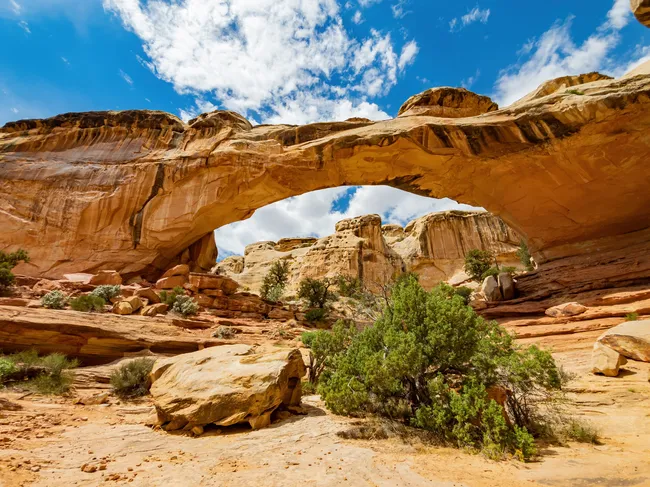
Shaka Guide’s tour of Capitol Reef will probably take you most of the day if you decide to visit all the stops and hike a few trails.
You can start the tour in Torrey or Hanksville, and follow the route in either an east or west direction.
Our tour takes you along historic Highway 24 and into the Fruita area of the park’s Waterpocket Fold district.
There are also optional, but highly recommended side trips.
Tips
Here are some Shaka Guide tips for visiting Capitol Reef:
- Download Shaka Guide’s tour of Capitol Reef National Park
- Be patient. Capitol Reef doesn’t get the same crowds as Arches and Zion, but its smaller infrastructure can get just as crowded.
- Bring plenty of water and sun protection.
- If you’re hiking, wear proper shoes, and always stay on marked trails.
- Keep an eye on the weather, and avoid entering any canyons if it’s raining.
- Stay late inside the park for incredible views of the night sky.
Honorable Mentions: Not national parks, but include other tours
Here are a few honorable mentions. While these aren’t national parks, they are totally worth a visit, and Shaka Guide has tours of all three.
The La Sal Mountain Loop

Looming over Moab are the La Sal Mountains, visible from both Arches and Canyonlands.
If you’d like to explore these towering giants, then download Shaka Guide’s tour of the La Sal Mountain Loop.
Mountain lakes, scenic overlooks, incredible rock formations, famous Hollywood filming locations, and even dinosaur footprints await you on this mountain drive.
Goblin Valley State Park

Just a short drive north of Hanksville, Utah, you can find Goblin Valley State Park.
This one-of-a-kind valley is full of short rock formations called hoodoos, or goblins.
You can stroll through a valley, filled with thousands of goblins, and learn all about the history of the park with Shaka Guide at the helm.
Grand Staircase-Escalante National Monument

Most of the grand staircase is only accessible by high-clearance, all-wheel drive vehicles, or on foot.
But Shaka Guide will take you on a tour of scenic Byway 12, and Highway 89, through and around the northern parts of the national monument.
This tour starts in Torrey, near Capitol Reef, and connects you to the Grand Staircase, Bryce Canyon, and Zion National Park, before ending up in Kanab, Utah, just north of the state border with Arizona.
It’s the perfect way to make a road trip out of all these fabulous destinations!
Final Thoughts
As you can see, ranking these five Utah National Parks is a task as big as the parks themselves.
There’s just no getting around the fact that each of these parks is special and worth a visit.
Hiking, wildlife, natural wonders, and history - each one of Utah’s Mighty Five has it in spades.
Download Shaka Guide’s audio tour tour bundle of Utah’s Mighty Five National Parks today, and experience the might for yourself.
Take the Utah Mighty 5 Audio Tour Bundle with Shaka Guide and explore at your own pace with stories, directions, and must-see stops along the way.
Need help? Email us anytime at aloha@shakaguide.com!
Like this article? Share it on Pinterest!

RELATED ARTICLES:

 Buy Gift Card
Buy Gift Card


